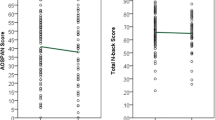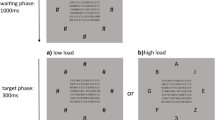Abstract
Inattentional blindness (IB) occurs when an observer, who is engaged in a resource-consuming task, fails to notice an unexpected although salient stimulus appearing in their visual field. The incidence of IB is affected by changes in stimulus-driven properties, but little research has examined individual differences in IB propensity. We examine working memory capacity (WMC), processing styles (flicker task), inhibition (Stroop task), and training in predicting IB. WMC is associated with IB (Experiments 1 and 2) but neither processing style (Experiment 1) nor inhibition (Experiment 2) was associated. In Experiment 2, prior training on a task reduced the incidence of IB compared to no prior training, and this effect was significantly larger when trained on the same tracking task as that used in the IB task rather than a different task. We conclude that IB is related to WMC and that training can influence the incidence of IB.




Similar content being viewed by others
References
Ansari, D., Lyons, I. M., van Eitneren, L., & Xu, F. (2007). Linking visual attention and number processing in the brain: The role of the temporo-parietal junction in small and large symbolic and non-symbolic number comparison. Journal of Cognitive Neuroscience, 19, 1845–1853.
Austen, E., & Enns, J. T. (2000). Change detection. Paying attention to detail. Psyche, 6(11). http://psyche.cs.monash.edu.au/v6/psyche-6-11-austen.html.
Baddeley, A. D., & Hitch, G. (1974). Working memory. In G. H. Bower (Ed.), The psychology of learning and motivation: Advances in research and theory (Vol. 8, pp. 47–89). New York: Academic Press.
Becklen, R., & Cervone, D. (1983). Selective looking and the noticing of unexpected events. Memory & Cognition, 11(6), 601–608.
Beech, A. R., Powell, T. J., McWilliams, J., & Claridge, G. S. (1989). Evidence of reduced “cognitive inhibition” in schizophrenia. British Journal of Psychology, 78, 349–356.
Bleckley, M. K., Durso, F. T., Crutchfield, J. M., Engle, R. W., & Khanna, M. M. (2003). Individual differences in working memory capacity predict visual attentional allocation. Psychonomic Bulletin & Review, 10, 884–889.
Boot, W. R., Kramer, A. F., Simons, D. J., Fabiani, M., & Gratton, G. (2008). The effects of video game playing on attention, memory, and executive control. Acta Psychologia, 129, 387–398.
Boucart, M., Mobarek, N., Cuervo, C., & Danion, J. M. (1999). What is the nature of increased Stroop interference in schizophrenia. Acta Psychologica, 101, 3–25.
Brown, R. G., & Mardsen, C. D. (1988). Internal versus external cues and the control of attention in Parkinson’s disease. Brain, 111, 323–345.
Cartwright-Finch, U., & Lavie, N. (2007). The role of perceptual load in inattentional blindness. Cognition, 102(3), 321–340.
Cohen, J. D., Perlstein, W. M., Braver, T. S., Nystrom, L. E., Noll, D. C., Jonides, J., et al. (1997). Temporal dynamics of brain activation during a working memory task. Nature, 386, 604–608.
Conway, A. R. A., Cowan, N., & Bunting, M. F. (2001). The cocktail party phenomenon revisited: The importance of working memory capacity. Psychonomic Bulletin & Review, 8, 331–335.
Conway, A. R. A., & Engle, R. W. (1994). Working memory and retrieval: A resource-dependent inhibition model. Journal of Experimental Psychology: General, 123, 354–373.
Conway, A. R. A., Tuholski, S. W., Shisler, R. J., & Engle, R. W. (1999). The effect of memory load on negative priming: An individual differences investigation. Memory & Cognition, 27, 1042–1050.
Corbetta, M., Kincade, J. M., & Shulman, G. L. (2002). Neural systems for visual orienting and their relationships to spatial working memory. Journal of Cognitive Neuroscience, 14, 508–523.
Cowan, N. (2001). The magical number four in short-term memory: A reconsideration of mental storage capacity. Behavioural & Brain Sciences, 24, 87–114.
Daneman, M., & Carpenter, P. A. (1980). Individual differences in working memory and reading. Journal of Verbal Learning and Verbal Behavior, 19, 450–466.
Egeth, H. E., & Yantis, S. (1997). Visual attention: Control, representation, and time course. Annual Review of Psychology, 48, 269–297.
Folk, C. L., Remington, R. W., & Johnston, J. C. (1992). Involuntary covert orienting is contingent on attentional control settings. Journal of Experimental Psychology: Human Perception and Performance, 18, 1030–1044.
Green, C. S., & Bavelier, D. (2007). Action video game experience alters the spatial resolution of attention. Psychological Science, 18, 88–94.
Hannon, E. M., & Richards, A. (2009). Is inattentional blindness related to individual differences in visual working memory capacity or executive control functioning. Perception (in press).
Hasher, L., & Zacks, R. L. (1988). Working memory, comprehension and aging: A review and a new view. In G. Bower (Ed.), The psychology of learning and motivation (Vol. 22, pp. 193–225). San Diego, CA: Academic Press.
Kane, M. J., Bleckley, K. M., Conway, A. R. A., & Engle, R. W. (2001). A controlled-attention view of working-memory capacity. Journal of Experimental Psychology: General, 130, 169–183.
Lavie, N. (2005). Distracted and confused? Selective attention under load. Trends in Cognitive Science, 9, 75–82.
Lavie, N. (2006). The role of perceptual load in visual awareness. Brain Research, 1080(1), 91–100.
Mack, A., & Rock, I. (1998). Inattentional blindness. Cambridge, MA: MIT Press.
Marois, R., Leung, H. C., & Gore, J. C. (2000). A stimulus-driven approach to object identity and location processing in the human brain. Neuron, 25, 717–728.
Most, S. B., Simons, D. J., Scholl, B. J., & Chabris, C. F. (2000). Sustained inattentional blindness: The role of location in the detection of unexpected dynamic events. Psyche, 6(14). http://psyche.cs.monash.edu.au/v6/psyche-6-14-most.html.
Most, S. B., Simons, D. J., Scholl, B. J., Jimenez, R., Clifford, E., & Chabris, C. F. (2001). How not to be seen: The contribution of similarity and selective ignoring to sustained inattentional blindness. Psychological Science, 12(1), 9–17.
Navon, D. (1977). Forest before trees: The precedence of global features in visual perception. Cognitive Psychology, 9, 353–383.
Neisser, U. (1979). The control of information pickup in selective looking. In A. D. Pick (Ed.), Perception and its development (pp. 201–219). Hillsdale, NJ: Lawrence Erlbaum Associates.
Neisser, U., & Becklen, R. (1975). Selective looking: Attending to visually specified events. Cognitive Psychology, 7(4), 480–494.
Simons, D. J. (2003). Surprising studies of visual awareness (DVD). Champaign, IL: Viscog Productions. http://www.viscog.com.
Simons, D. J., & Chabris, C. F. (1999). Gorillas in our midst: sustained inattentional blindness for dynamic events. Perception, 28, 1059–1074.
Simons, D. J., & Jensen, M. S. (2009). The effects of individual differences and task difficulty on inatttentional blindness. Psychonomic Bulletin & Review, 16, 398–403.
Snodgrass, J. G., & Corwin, J. (1988). Pragmatics of measuring recognition memory: Applications to dementia and amnesia. Journal of Experimental Psychology: General, 177, 34–50.
Stroop, J. R. (1935). Studies of interference in serial verbal reactions. Journal of Experimental Psychology, 18, 643–662.
Todd, J. J., Fougnie, D., & Marois, R. (2005). Visual short-term memory load suppresses temporo-parietal junction activity and induces inattentional blindness. Psychological Science, 16(12), 965–972.
Todd, J. J., & Marois, R. (2004). Capacity limit of visual short-term memory in human posterior parietal cortex. Nature, 428, 751–754.
Turner, M. L., & Engle, R. W. (1989). Is working memory capacity task dependent? Journal of Memory and Language, 28(2), 127–154.
Unsworth, N., Heitz, R. P., Schrock, J. C., & Engle, R. W. (2005). An automated version of the operation span task. Behaviour Research Methods, 37(3), 498–505.
Vitkovitch, M., Bishop, S., Dancey, C., & Richards, A. (2002). Stroop interference and negative priming in patients with multiple sclerosis. Neuropsychologia, 40, 1570–1576.
Vogel, E. K., McCollough, A. W., & Machizawa, M. G. (2005). Neural measures reveal individual differences in controlling access to working memory. Nature, 438, 500–503.
Acknowledgments
This work is supported by the Leverhulme Foundation awarded to the first author under grant number F/07 112/R.
Author information
Authors and Affiliations
Corresponding author
Rights and permissions
About this article
Cite this article
Richards, A., Hannon, E.M. & Derakshan, N. Predicting and manipulating the incidence of inattentional blindness. Psychological Research 74, 513–523 (2010). https://doi.org/10.1007/s00426-009-0273-8
Received:
Accepted:
Published:
Issue Date:
DOI: https://doi.org/10.1007/s00426-009-0273-8




